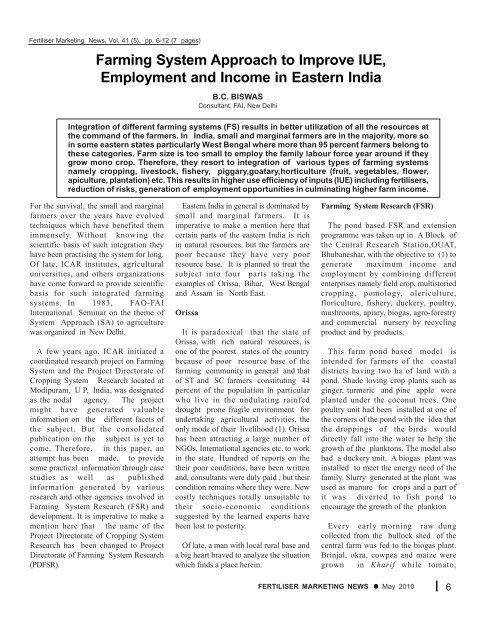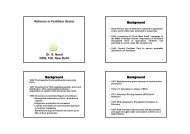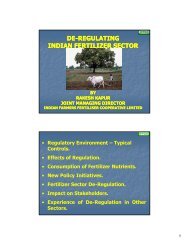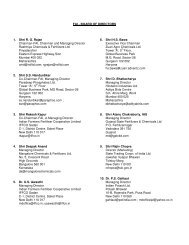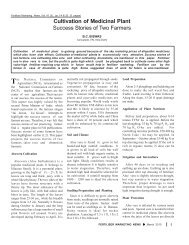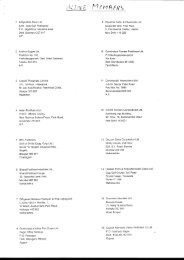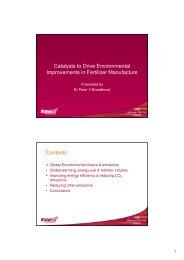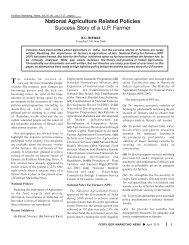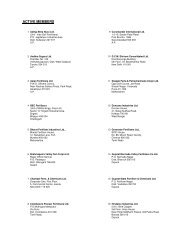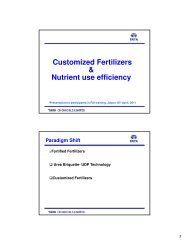Farming System Approach to Improve IUE, Employment and Income ...
Farming System Approach to Improve IUE, Employment and Income ...
Farming System Approach to Improve IUE, Employment and Income ...
You also want an ePaper? Increase the reach of your titles
YUMPU automatically turns print PDFs into web optimized ePapers that Google loves.
Fertiliser Marketing News, Vol. 41 (5), pp. 6-12 (7 pages)<strong>Farming</strong> <strong>System</strong> <strong>Approach</strong> <strong>to</strong> <strong>Improve</strong> <strong>IUE</strong>,<strong>Employment</strong> <strong>and</strong> <strong>Income</strong> in Eastern IndiaB.C. BISWASConsultant, FAI, New DelhiIntegration of different farming systems (FS) results in better utilization of all the resources atthe comm<strong>and</strong> of the farmers. In India, small <strong>and</strong> marginal farmers are in the majority, more soin some eastern states particularly West Bengal where more than 95 percent farmers belong <strong>to</strong>these categories. Farm size is <strong>to</strong>o small <strong>to</strong> employ the family labour force year around if theygrow mono crop. Therefore, they resort <strong>to</strong> integration of various types of farming systemsnamely cropping, lives<strong>to</strong>ck, fishery, piggary,goatary,horticulture (fruit, vegetables, flower,apiculture, plantation) etc. This results in higher use efficiency of inputs (<strong>IUE</strong>) including fertilisers,reduction of risks, generation of employment opportunities in culminating higher farm income.For the survival, the small <strong>and</strong> marginalfarmers over the years have evolvedtechniques which have benefited themimmensely. Without knowing thescientific basis of such integration theyhave been practising the system for long.Of late, ICAR institutes, agriculturaluniversities, <strong>and</strong> others organizationshave come forward <strong>to</strong> provide scientificbasis for such integrated farmingsystems. In 1983, FAO-FAIInternational Seminar on the theme of<strong>System</strong> <strong>Approach</strong> (SA) <strong>to</strong> agriculturewas organized in New Delhi.A few years ago, ICAR initiated acoordinated research project on <strong>Farming</strong><strong>System</strong> <strong>and</strong> the Project Direc<strong>to</strong>rate ofCropping <strong>System</strong> Research located atModipuram, U P, India, was designatedas the nodal agency. The projectmight have generated valuableinformation on the different facets ofthe subject. But the consolidatedpublication on the subject is yet <strong>to</strong>come. Therefore, in this paper, anattempt has been made, <strong>to</strong> providesome practical information through casestudies as well as publishedinformation generated by variousresearch <strong>and</strong> other agencies involved in<strong>Farming</strong> <strong>System</strong> Research (FSR) <strong>and</strong>development. It is imperative <strong>to</strong> make amention here that the name of theProject Direc<strong>to</strong>rate of Cropping <strong>System</strong>Research has been changed <strong>to</strong> ProjectDirec<strong>to</strong>rate of <strong>Farming</strong> <strong>System</strong> Research(PDFSR).Eastern India in general is dominated bysmall <strong>and</strong> marginal farmers. It isimperative <strong>to</strong> make a mention here thatcertain parts of the eastern India is richin natural resources, but the farmers arepoor because they have very poorresource base. It is planned <strong>to</strong> treat thesubject in<strong>to</strong> four parts taking theexamples of Orissa, Bihar, West Bengal<strong>and</strong> Assam in North East.OrissaIt is paradoxical that the state ofOrissa, with rich natural resources, isone of the poorest states of the countrybecause of poor resource base of thefarming community in general <strong>and</strong> tha<strong>to</strong>f ST <strong>and</strong> SC farmers constituting 44percent of the population in particularwho live in the undulating rainfeddrought prone fragile environment forundertaking agricultural activities, theonly mode of their livelihood (1). Orissahas been attracting a large number ofNGOs, International agencies etc. <strong>to</strong> workin the state. Hundred of reports on thetheir poor conditions, have been written<strong>and</strong>, consultants were duly paid , but theircondition remains where they were. Newcostly techniques <strong>to</strong>tally unsuitable <strong>to</strong>their socio-economic conditionssuggested by the learned experts havebeen lost <strong>to</strong> posterity.Of late, a man with local rural base <strong>and</strong>a big heart braved <strong>to</strong> analyze the situationwhich finds a place herein.<strong>Farming</strong> <strong>System</strong> Research (FSR)The pond based FSR <strong>and</strong> extensionprogramme was taken up in A Block ofthe Central Research Station,OUAT,Bhubaneshar, with the objective <strong>to</strong> (1) <strong>to</strong>generate maximum income <strong>and</strong>employment by combining differententerprises namely field crop, multis<strong>to</strong>riedcropping, pomology, olericulture,floriculture, fishery, duckery, poultry,mushrooms, apiary, biogas, agro-forestry<strong>and</strong> commercial nursery by recyclingproduct <strong>and</strong> by products.This farm pond based model isintended for farmers of the coastaldistricts having two ha of l<strong>and</strong> with apond. Shade loving crop plants such asginger, turmeric <strong>and</strong> pine apple wereplanted under the coconut trees. Onepoultry unit had been installed at one ofthe corners of the pond with the idea thatthe droppings of the birds woulddirectly fall in<strong>to</strong> the water <strong>to</strong> help thegrowth of the plank<strong>to</strong>ns. The model alsohad a duckery unit. A biogas plant wasinstalled <strong>to</strong> meet the energy need of thefamily. Slurry generated at the plant wasused as manure for crops <strong>and</strong> a part ofit was diverted <strong>to</strong> fish pond <strong>to</strong>encourage the growth of the plank<strong>to</strong>nEvery early morning raw dungcollected from the bullock shed of thecentral farm was fed <strong>to</strong> the biogas plant.Brinjal, okra, cowpea <strong>and</strong> maize weregrown in Kharif while <strong>to</strong>ma<strong>to</strong>,FERTILISER MARKETING NEWS • May 2010 6
watermelon, cucumber, bitter gourd, <strong>and</strong>bottle gourd etc , were grown in theRabi season. Fodder crop was grown <strong>to</strong>supply greens <strong>to</strong> the dairy. Banana,mango, ber, lemon <strong>and</strong> yam had beenplanted around the pond <strong>to</strong> utilize all theavailable space. An ornamental unit wasdeveloped in front of the farm house <strong>to</strong>provide the mental food. The area allotted<strong>to</strong> different components of the farm ismentioned in Table 1.The income generated has beenindicated in the Table 2.The data mentioned in Table 2 indicatethat a net profit of Rs 58367.00 could begenerated from <strong>Farming</strong> <strong>System</strong><strong>Approach</strong> in a Research Farm (RF) (1). Itwould be worth while <strong>to</strong> examine if theFSA is employed in farmer’s field. Astudy was, therefore, conducted in thefarm of a marginal farmer, Minati Behera,in Banshipatna village of Bhadrak distric<strong>to</strong>f Orissa (2).Area allocation <strong>to</strong> differentcomponent in farming system has beenmentioned in Table 3.The Economies of the (IFS) Integrated<strong>Farming</strong> <strong>System</strong> has been mentioned inTable 4.The data on the economics of IFSindicated that agroforestry <strong>and</strong> pomologyunit yielded the maximum return of Rs 5.60<strong>and</strong> Rs 4.90/Re invested, respectivelyfollowed by vegetables farming (Rs3.79/Re) Rice (low l<strong>and</strong> rice) yield being thelowest. Return from fishery was also low.It might be due <strong>to</strong> local fish culture, notthe composite culture (2).It is interesting <strong>to</strong> note that the overallsuccess with respect <strong>to</strong> economics <strong>and</strong>employment generation from the systemwas quite high. About an acre areagenerated a net return of Rs 47,825 withan investment of Rs 18,515 <strong>and</strong> alsoemployment generation of 248 m<strong>and</strong>ays.Manure generated from dairy unit betterulitised by vegetables. Likewise ricegenerated straw which was used by thedairy unit Thus, the synergy amongTable 1 – Area allocation <strong>to</strong> different components in FSR unit atCRS, OUAT, BhubaneshwarParticular Area (sq. m) PercentageFarm house 100Threshing floor 300 2.30Cattle shed &apiary 36Biogas plant 12Pisciculture 3128 15.6(duckery, poultry)Floriculture 500 2.5Multis<strong>to</strong>ried 2080 10.4croppingsLow l<strong>and</strong> crop 3200 16.0Upl<strong>and</strong> crop 2550 12.80Mushroom, agroforestry,Forage unit, compost pit, 7674 38.4Irrigation, drainage etc.Total 20,000 100Table 2 – <strong>Income</strong> generated by the different componentsS.No Component Total Total Gross Net Return/Rs.labour cost (Rs.) returns (Rs.) returns (Rs.) invested(M<strong>and</strong>ays)(Rs.)1 Field crop (rice, 98.2 3315 8954 5638 2.70maize, rice bean)2 Multis<strong>to</strong>ried 87.0 3831 12920 9089 3.37cropping (Coconut,ginger, turmeric, pine apple)3 Banana, papaya 18.4 900 2366 1466 2.634 Vegetables 96.4 3812 12114 8310 3.18(brinjal, okra, pota<strong>to</strong>,<strong>to</strong>ma<strong>to</strong> etc)5 Floriculture 4.0 125 225 100 1.86 Fishery (multi layer) 31.0 3722 20326 16603 5.467 Poultry 23.0 9240 10221 981 1.118 Duckery 23.0 5387 6100 713 1.139 Mushroom 180.0 18184 31040 12856 1.7010 Apiary 1.0 170 1350 1180 7.9111 Biogas 11 600 2031 1431 3.33Total 573 49286 107645 58367 2.18Source : (1)7FERTILISER MARKETING NEWS • May 2010
The field design consisted of (1) widedykes all around a pond refugeconnected <strong>to</strong> two sides trenches (microwatershed cum-fish refuge) with aguarded outlet.Rice was the main componen<strong>to</strong>ccupying 60 % area. Horticultural cropswere lemon, orange, guava, papaya,coconut, arecanut, marigold, tuberose,<strong>and</strong> seasonal vegetables. Teak was theagro-forestry component.Pond refuge with a size of 30 X 12X 2mwas constructed at the lower (downslope)end of the field occupying 7 %area. The trenches with 2.5 m widthoccupying 10 % area were constructedadjacent <strong>to</strong> dykes along thelongituditional side of the field whichwere connected <strong>to</strong> pond refuge at oneend. The trench bot<strong>to</strong>m had a gentle slopeof 0.75 <strong>to</strong>wards the pond refuge (7).Production TechnologyRiceRice-rice-rice cropping system wasfollowed. All the locally suitablerecommended package of practices wereadoptedFishFingerlings, <strong>to</strong>taling 6250 in number, ofcatla, rohu, mrigal, bata, silver carp etc.were released in the pond in the first weekof July. Locally suited recommendedpractices were employed.HorticultureAll major branches of horticulturenamely pomology (banana, lemon, orange,papaya, coconut, arecanut etc.),olericulture (vegetables like brinjal,radish, <strong>to</strong>ma<strong>to</strong>, pumkin, poi, spinach,climbing <strong>and</strong> creeper vegetables likecountry bean, bottle gourd, ash gourdetc.), floriculture (marigold, tuberose etc.)were included. Teak was the maincomponent of agroforestry.10% of construction cost+interest on<strong>to</strong>tal cost is taken as the deprecation cost.The data presented in Table 5indicates that the incomes generated inTable 5 – Economics of rice-fish farming system in the Ist yearComponents Operational cost (Rs) Gross return (Rs) Net return (Rs)Farm construction* 6000.00Rice 17106.00 25387.00 8281.00Fish 8650.00 17180.00 8530.00Horticulture 1400.00 1825.00 425.00Total 33156.00 44382.00 11226.00rice <strong>and</strong> fish components were almostequal.BiharA case study of a farm of about9600squre m owned by Shri RajendraKumar of village Priyanagar, districtSaharsa, about 95 km away (North –East)of Patna, the capital city of Bihar has beentaken up <strong>to</strong> find out the impact of IFSAon the <strong>IUE</strong>, employment generation, <strong>and</strong>income over the existing system. TheDistrict HQ is only about 10 Km away butvery difficult <strong>to</strong> reach. The local marketSonbarsa Raj is only one km away fromthe village. The village houses about 500families (about 2500 population). Braindrain is a rule in this area rather than anexception. The intelligent, educatedpeople are mostly away <strong>to</strong> the differentcities of the country/ world <strong>and</strong> are invery good positions.The important crops grown are rice(autumn, winter <strong>and</strong> summer rice), autumnmoong, maize (autumn, winter <strong>and</strong> summermaize, wheat( has less area than maize)barley, ragi, summer moong lentil, gram,khesari, pea, mustard sunflower, all kindsof vegetables (brinjal, <strong>to</strong>ma<strong>to</strong>, pota<strong>to</strong>,chilli being more important), mango,banana, guava, citrus, coconut etc.Fishery, agroforestry goatary, etc arecommon. Important constraints are flood,transport, marketing, availability of goodquality seeds, fertilisers, plant protectionmaterials etc. Last year (2009) the areainterestingly had floods without rain. TheKosi tributary called “Kamal”runs throughthe area.Table 6 indicates area allocation <strong>to</strong>different components in FS.Table 6 – Area allocation <strong>to</strong> various componentsComponent Particulars Number of units/plant Area (squ.m)Field crops<strong>System</strong> Rice-moong-maize/wheat 4800Mustard 489VegetablesBrinjal, <strong>to</strong>ma<strong>to</strong>, okra, pumpkins,bitter gourd, chilli etc. 1100Fruits Mango 48 480Banana 500 1250Guava 100 100Jackfruit 5 100Flower Marigold 50 50Agroforestry Mohua 5 50Jamun 5 100Sesum 30 120Bamboo 30 120Fishery Pond 1 500Goatary 10 50Farm house withthreshing floor, s<strong>to</strong>re etc. 300Total 96009FERTILISER MARKETING NEWS • May 2010
It is observed that less than one hectare(ha) area (9600 sq. m) generated an incomeof Rs.40295.00 per annum <strong>and</strong> employmentgeneration of 485 m<strong>and</strong>ays throughfarming system approach (FSA).Table 7 indicates income <strong>and</strong>employment generation from variouscomponents of FS.West BengalWest Bengal is one of those a fewstates which experienced severepressure of population on l<strong>and</strong> since thepartition of the country. It constitutes 8.07per cent of India’s population withhighest density of 904 persons/sq km.Bulk of the farm holdings are under small<strong>and</strong> marginal category. Besides this, anumber of these holdings are scatteredTable 7 –<strong>and</strong> fragmented. The cropping intensityhas reached up<strong>to</strong> 174 per cent. Agriculturein West Bengal is characterized by ricebased systems. Rice is grown throughoutthe year in three specific seasons, namelyAus (autumn), Aman (winter) <strong>and</strong> Boro(summer). It is grown in about 6.07 m ha.Mustard, pota<strong>to</strong>, sesame, greengram,pota<strong>to</strong> <strong>and</strong> jute are the other componentcrops. The state produces 72 percentcountry’s jute, 34 per cent pota<strong>to</strong>, 22percent tea <strong>and</strong> 15 percent of <strong>to</strong>tal rice. Itranks first in rice, vegetables, jute <strong>and</strong> fishproduction.The income from seasonal field crops insmall <strong>and</strong> marginal farms is hardlysufficient <strong>to</strong> sustain the farmer’s family.However, through proper farming systemapproach, good income <strong>and</strong> higherst<strong>and</strong>ard of living can be achieved even<strong>Income</strong> <strong>and</strong> employment generation from various components of FSComponent Area Gross Investment Net return RUE (Rs) Labour(squm) income (Rs) (Rs) (Rs) needs(M<strong>and</strong>ays)Agronomy 4800 26070.00 8395.00 13675.00 1.82 138rice 4800 3468.00 3100.00 368.00 0.11 45moong 4800 9600.00 2000.00 7600.00 3.80 25maize 2880 9547.00 2013.00 7534.00 3.70 42wheat 1920 3070.00 1094.00 1976.00 1.80 21mustard 480 389.00 192.00 197.00 1.02 5OlericultureBrinjal <strong>to</strong>ma<strong>to</strong>, 1100 12000.00 6930.00 5070.00 0.73 85okra,Pomology 1930 14950.00 7450.00 7500.00 1.00 155Mango 480 4800.00 2500.00 2300.00 0.92Banana 1250 8750.00 4500.00 4250.00 0.94Guava 100 400.00 200.00 200.00 1.00Jackfruit 100 1000.00 250.00 750.00 3.00Dairy 40 15000.00 12000.00 3000.00 0.25 70Agroforestry 3400.00 750.00 2650.00 3.5 5Fishery 500 6000.00 2000.00 4000.00 2.00 20Duckery 10 2000.00 500.00 1500.00 3.00 12Total 9600 79324.00 39029.00 40295.00 1.08 485from small holdings. A farming systemrepresent appropriate combination of farmenterprises viz. cropping system,lives<strong>to</strong>ck, poultry, fishery, forestry etc. <strong>and</strong>the means available <strong>to</strong> farmer <strong>to</strong> raisethem for increasing profitability.A good farming system should ensure♦ Self sufficiency in farmers’requirement of food <strong>and</strong> cash.♦ Increased income <strong>and</strong> employmen<strong>to</strong>pportunities,♦ Recycling of farm wastes <strong>and</strong>byproducts <strong>and</strong>,♦ Increased operational efficiency byefficient use of resources.The farmer has <strong>to</strong> undertake some l<strong>and</strong>based enterprises which will complementtheir cropping activity <strong>and</strong> will get moreincome <strong>and</strong> employment, thus leading <strong>to</strong>higher social <strong>and</strong> economic upliftment.Keeping above facts in view, a case studyof a farmer in West Bengal wasundertaken.Method EmployedA personal interview at the farmstead ofa representative farmer who follows thefarming system approach was undertaken(Table 8). The detailed economics of thecultivation was calculated based on theinformation provided by the farmerverbally.The farmer under study followed Jute– Rice –Mustard system last year. He alsopractised other enterprises likehorticulture, animal husb<strong>and</strong>ry, fisheriesetc.ResultsThe detailed analysis of eachcomponent practised by the farmer isgiven as under:Cropping <strong>System</strong>Jute : Before partition of the country, Jutewas unknown <strong>to</strong> the local people of thisFERTILISER MARKETING NEWS • May 201010
area. Farmers in this part used <strong>to</strong> growonly one rice crop. After partition, farmerswho migrated from Bangladesh settled inthis area. As they knew the technique ofJute extraction they started growing jute.This has become a very important cashcrop in this area having facilities of rettingin ponds <strong>and</strong> other water bodies. Jute isa very labour intensive crop whichprovides employment <strong>to</strong> large number ofpoor people. Its leaves are used asvegetables, fibers provides cash whilestem is used as fuel <strong>and</strong> fencing materialsetc. Jute cultivation is profitable providedthe fiber price is reasonably high i.e. Rs.800-1000/ quintal. It is observed that thefarmers got a net profit of Rs. 1020 perbigha (Table 9).Rice: West Bengal ranks first in riceproduction in the country. With irrigation,two <strong>to</strong> three rice crops can be grown fromthe same l<strong>and</strong>. The farmer underdiscussion <strong>to</strong>ok rice after the harvest ofJute. It is seen that he used both organicmanures (oil cakes) <strong>and</strong> fertilisers mainlyN (urea) <strong>and</strong> P (SSP). He did not use Kfertiliser.Rice yield recorded was 8q/bigha(60q//ha) <strong>and</strong> net profit was only Rs. 647/bigha (Rs.4853 /ha) which is not high(Table 10). But as the rice is staple foodof the people of the area, it always findsa place in the cropping system practised.Mustard : Since mustard oil is used asmain cooking medium by the local peopleit also finds a place in the croppingsystem. The farmer <strong>to</strong>ok mustard afterrice. It is interesting <strong>to</strong> note here that thelocal farmers have been practicing zerotillage for many years <strong>to</strong> save time <strong>and</strong>money. The profit per bigha was Rs. 380(Table 11).<strong>Income</strong> From the Cropping <strong>System</strong>It is observed that the cropping systemgave an income of Rs. 16888 only <strong>and</strong> ou<strong>to</strong>f the three crops jute gave the highestamount of profit (49.8 %).Small <strong>and</strong> marginal farmers whodominate in West Bengal (90%) are notable <strong>to</strong> survive if they have <strong>to</strong> depend onfield crops only <strong>and</strong> which are very oftendestroyed by floods <strong>and</strong> other weatheraberrations. This is why they practiseother systems like horticulture, animalhusb<strong>and</strong>ry, fishery etc.HorticultureIt is observed that in the home stead,the farmer grows coconut, mango,jackfruit, guava, areca nut, lemon, banana,date palm, palmyra palm etc. The farmerunder discussion makes an earning ofabout Rs.7825 /annum from horticulturalsystem (Table 12).Animal <strong>System</strong>Animal system is a very importantcomponent of farming system associatedwith the farmers of this area. This providesemployment, milk <strong>and</strong> dung which is usedfor generating energy <strong>and</strong> manure .Thefarmer in question owns 3 animal (2 adultcows). He has also installed a biogasplant, rears 10 ducks (9+1). The reportedincome is about Rs. 24950 per annumwhich seems <strong>to</strong> be at higher side (Table13).Fishery <strong>System</strong>Rice <strong>and</strong> fish go well in Bengal. Thefarmer has a small pond (¼th bigha) whichhad provided income of Rs. 1000/- in thefirst year itself in addition <strong>to</strong> familyconsumption (Table 14).Total <strong>Income</strong>Total income of the farmer amounts <strong>to</strong>be Rs. 50663 per annum which seems <strong>to</strong>be reasonably adequate <strong>to</strong> run a smallfamily of 3 adult <strong>and</strong> 2 minor (Table 15).CONCLUSIONTHE ENTIRE PHILOSOPHY OF FARMINGsystem revolves around better utilizationof time, money, resources <strong>and</strong> familylabour. The farm family gets scope forgainful employment round the yearthereby ensuring good income <strong>and</strong>higher st<strong>and</strong>ard of living even fromsmall holdings. From the above study itis clear that the small size farms can earna living provided the farmer does all thefield operations as well as marketinghimself. The income can be furtherincreased if the farming system ismanaged so as <strong>to</strong> harvest the crop duringfestivals. Early harvest can also help <strong>to</strong>get high price.Table 8 – Particulars of farmer under studyName (Changed) : Sunil Kumar M<strong>and</strong>alVillage : BikehatP.O. : BeraDistrict : BurdwanL<strong>and</strong> Holding : Irrigated 5.5 BighaUnirrigated2.75 BighaTotal8.25 BighaNumber of Family Members : 3 adults & 2 minorsTable 9 – Economics of Jute cultivation by the farmerS.No. Particulars Amount (Rs.)ACost of Cultivation (per Bigha)1. Ploughings (@ Rs. 80 /ploughing) -3 2402 Irrigation -1 1503 Seed – 1 kg 304 Weeding ( 6+6+4 labour @ Rs. 40) -3 6405 Thinning (6 labour) 2406 Harvesting (5 labour) 2007 Transporting water 2008 Retting (2 labour) 809 Transporting (5 labour) 16010 Drying 80Total 1780B Yield 3.5 q/Bigha (@ Rs. 800/q) 2800C Profit (per Bigha) 1020D Profit (per hectare) 765011FERTILISER MARKETING NEWS • May 2010
Table 10 – Economics of rice cultivation by the farmerS.No. Particulars Amount (Rs.)A Cost of cultivation (per Bigha)1 Ploughings (@ Rs. 150/ ploughing) 4502 Seed bed preparationSeed – 10 kg 120Watering 50Ploughing 803 ManuringOilcake (@ Rs 8/kg) – 50 kg 400SSP – 50 kg 150Urea( 21 DAT) -15 kg 77Urea (20 days later)- 30 kg 154Urea (10 -15 days later) 1024 IrrigationContract with shallow tubewell 800Labour 2005 Weeding -21 st Weeding (4 labour @ Rs. 40) 1602 nd Weeding (6 labour) 2406 Harvesting (4 labour @ Rs.45) 1807 Bundle making (3 labour @ Rs 45) 1358 Transporting (3 labour @Rs. 45) 1359 Threshing (4 labour @ Rs. 45) 18010 Drying 40Total 3653B. <strong>Income</strong>Grain yield 8 q/Bigha (@ Rs. 500/q) 4000Straw 300Total 4300C Profit (per Bigha) 647D Profit (per hectare) 4853Table 11 – Economics of mustard cultivation by the farmerS.No. Particulars With l<strong>and</strong> Without l<strong>and</strong>preparation preparation(Rs.)(Rs.)A Cost of cultivation (per Bigha)1 L<strong>and</strong> preparation 240 302 Seed 30 303 Weeding 80 804 Fertiliser 500 5005 Harvesting 200 2006 Threshing 180 180Total 1230 1020B Yield (@1400/q) 1400 1400C Profit (per Bigha) 170 380D Profit (per hectare) 1275 2850Table 12 – <strong>Income</strong> from horticultural systemadopted by the farmerS.No. Particulars Amount (Rs.)1 Coconut (10 plants) – 800 nuts 20002 Mango (7 plants) – 560 kg 11203 Jackfruit (@ Rs. 25 /fruit) -25 6254 Guava (8 plants) – 120 kg 12005 Arecanut 2006 Lemon (2 plants) -20 2007 Banana 20008 Date palm 809 Palmyra Palm (5 plants) – 5 X40 nuts 400Total 7825Table 13 – <strong>Income</strong> from animal system adopted by the farmerS.No. Particulars Amount (Rs.)1 3 Cows (2 adult) 10X30 X10 150002 Gobar Gas plantGas 3700Manures (@ 5 <strong>to</strong>nnes/animal) 4000Total 227003 Ducks 2250Total 24950Table 14 – <strong>Income</strong> from fishery system adopted by the farmerS.No. Particulars Amount (Rs.)A Cost of digging 0.25 Bigha pond 2000B <strong>Income</strong>Fish Sale 1500Fish consumed 1500C Profit 1000Table 15 – Total income of the farmer from all system adoptedS. No. <strong>System</strong> Amount (Rs.)1 Jute- Rice-Mustard 168882 Horticulture 78253 Animals 249504 Fisheries 1000Total 50663REFERENCES1. Behera, U K Management of Resources By Small <strong>and</strong> MarginalFarmers in the H<strong>and</strong>icapped Regions of Orissa, A Thesis submitted<strong>to</strong> OUAT, Bhubaneshwar for the award of Ph.D in Agronomy (1994).2. Behera, U K, Behera, B C <strong>and</strong> Mohapatra, P C, Indian Fmg,August, (2006).3. Biswas, B C , Tewatia, R K <strong>and</strong> Shukla, D K, Indian J of Fert4(10) 31-43 (2008).4. Biswas, B C , Lalit Kumar <strong>and</strong> Shukla, D K, Indian J Fert 5(5)33-36 (2009).5. Kathiresan, R M , Indian J Agron 54(1), 9-14 (2009).6. Gill, M S, Singh, J P, <strong>and</strong> Gangwar, K S, Indian J Agron,54(2)128-139 (2009).7. Rautaray, S K., Das P. C. <strong>and</strong> Sinhababu, D.P., Indian J agricSci, 75(2) 79-82 (2005).FERTILISER MARKETING NEWS • May 201012


